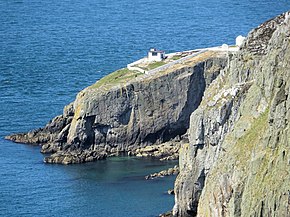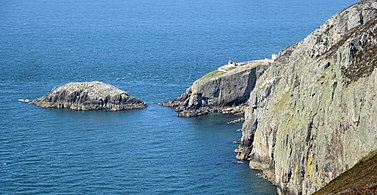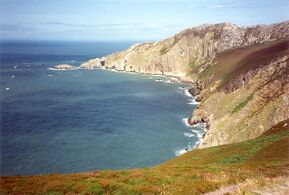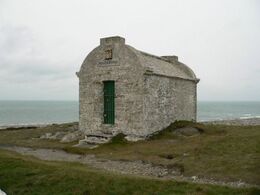North Stack
Topic: Earth
 From HandWiki - Reading time: 2 min
From HandWiki - Reading time: 2 min
| Native name: Ynys Arw | |
|---|---|
 North Stack (centre), with a building from the defunct fog warning station (right) | |
| Geography | |
| Location | Anglesey, Wales |
| Coordinates | [ ⚑ ] : 53°20′00″N 4°41′00″W / 53.333332°N 4.683333°W |
| Administration | |
Wales | |
| County | Anglesey |
| Demographics | |
| Population | 0 (uninhabited) |
North Stack (Welsh: Ynys Arw, meaning "rugged island") is a small island situated just off Holy Island on the north-west coast of Anglesey.[1] The area has been an important location in the development of traditional climbing in Britain and has several notable classic, and also extreme, climbing routes.
Description
North Stack is the site of a redundant fog warning station, comprising a number of buildings, including the Trinity House Magazine, built-in 1861, where shells for the warning cannon were stored. These buildings now house a bird-watching observatory,[2] giving a view of South Stack lighthouse across Gogarth Bay,[2] and the studio of artist Philippa Jacobs.[3]
North Stack, or Gogarth North Stack, can also refer to the headland opposite the island.
Rock climbing
The Precambrian quartzite cliffs of this headland, including the North Stack Walls and Wen Zawn, are a well-regarded area for rock climbs in Britain, and contain important traditional climbing routes such as A Dream of White Horses (HVS 4c, Ed Drummond and Dave Pearce, 1968), The Cad (E6 6a, Ron Fawcett, 1978), Skinhead Moonstomp (E6 6b, Andy Pollitt, 1986), The Bells, The Bells! (E7 6b, John Redhead, 1980), Conan the Librarian (E7 6b, Johnny Dawes, 1986), and The Hollow Man (E8 6b, Andy Pollitt, 1988).[4][5][6]
Crash site
The stack was the site of a crash of a B-24 bomber of the US Eighth Air Force on 22 December 1944 that killed the eight crew on board.[7]
Gallery
References
- ↑ "Holyhead Mountain, North Stack to Penrhyn Mawr", ccw.gov.uk. Retrieved 31 December 2010.
- ↑ 2.0 2.1 North Stack, holyhead.com. Retrieved 31 December 2010.
- ↑ "Artist profile: Philippa Jacobs", bbc.co.uk, Retrieved 31 December 2010.
- ↑ Gogarth North Stack (North Stack Wall), ukclimbing.com. Retrieved 31 December 2010.
- ↑ Gogarth North Stack (Wen Zawn), ukclimbing.com. Retrieved 31 December 2010.
- ↑ Panton, Simon (2015). Gogarth North. Llanberris, Wales: GroundUp. ISBN 978-0-9554417-1-4.
- ↑ "Anglesey World War II plane tragedy memorial service to be held on 70th anniversary, daily.co.uk, Retrieved 17 December 2014.
External links
 |
 KSF
KSF



